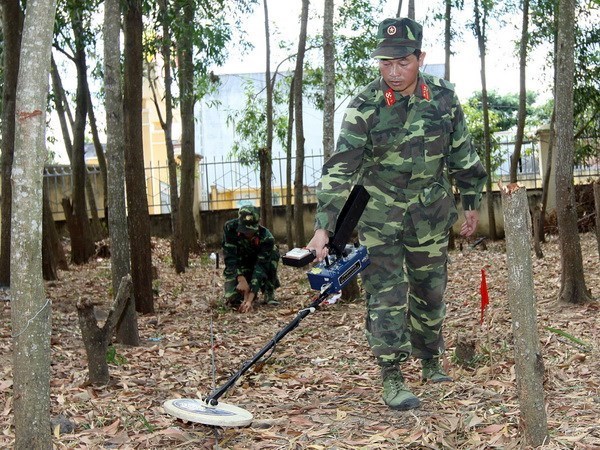
Several foreign-funded projects have been conducted in the central province of Quang Tri over the past two decades, helping the locality to clear bombs and mines left from war.

Sappers are
searching for war-left bombs and mines (Source: VNA)
Quang Tri is one of localities most affected by the aftermath of
war, with 81 percent of the province’s total area polluted with unexploded
ordnance (UXO).
Statistics from the provincial centre for overcoming bomb and mine consequences
show that by April 2018, bomb and mine accidents had killed 3,430 people and
injured 5,100 others, including many children.
Demining projects in Quang Tri have been funded by many foreign agencies,
including the foreign ministries of Germany, the US and Norway, the
Federal Ministry of Economic Cooperation and Development of
Germany, the UK’s Department for International Development, Ireland’s
development assistance fund, UNICEF and the US organisation Peace
Trees.
The projects have helped clear 132 million sq.m of seriously polluted areas,
and safely handle more than 650,000 bombs, mines and other UXO.
More than 350,000 people were provided with knowledge and skills to prevent UXO
accidents via the "Mine Risk Education (MRE)” programme.
Local authorities have also paid attention to supporting local victims of
war-era UXO, helping them improve their living conditions and re-integrate
into the community.
Non-governmental organisations have financed the building of 332 humanitarian
houses, and directly aided 215 UXO victims and their families.
Some 1,200 UXO victims who are living with disabilities were provided with
medical examination and prosthetics and other orthopedic instruments, while 50
disabled people and medical workers were trained in community-based
rehabilitation.
Nguyen Duc Thien from the provincial centre for overcoming bomb and mine
consequences said demining projects have contributed to expanding safe
land area for production in the locality.
To improve the work, the locality will set up a mine action centre, he said,
adding that Quang Tri hopes to receive greater support and resources for the
scheme.-
Source: VNA
The Department of Education and Training of Hoa Binh province held a conference on March 18 to review the performance of the "Safe and Happy School" Project and set out tasks for 2025. The project, funded by the Taiwan Fund for Children and Families (TFCF), aims to create a safe, inclusive, and supportive learning environment for students. The event saw the attendance of representatives from the TFCF and 26 beneficiary schools.
With over 70% of their workers being women, trade unions across industrial parks (IPs) in Hoa Binh have been actively safeguarding their legal rights and interests while implementing initiatives to improve their income and well-being.
In recent years, the Hoa Binh provincial General Hospital has continuously innovated itself and improved the quality of medical services to meet the increasing needs of local people. With substantial investments in infrastructure and modern equipment, along with a team of highly qualified doctors and nurses, the hospital has gradually established itself as one of the leading medical units in the Northwestern region and a trusted destination for healthcare for people inside and outside the province.
From mastering the fundamentals of programming to achieving national recognition, the Programming Club of the Le Van Tam Primary School (STAR LVT28) in Hoa Binh city has made remarkable strides in the field of robotics.
The Ho Chi Minh Communist Youth Union Committee and the Vietnam Youth Federation chapter of Hoa Binh province organised a programme on March 12 to launch the "Digital Literacy" movement and an online quiz on the resolutions of the Vietnam Youth Federation congresses at all levels, as well as the Politburo's Resolution No. 57-NQ/TW on breakthroughs in the development of science, technology, innovation, and national digital transformation.
As climate change grows more unpredictable, the development of production forests has become essential - not just for economic growth, but for safeguarding the environment and maintaining ecosystem balance. By boosting local incomes, curbing natural disasters, preventing soil erosion, and protecting water resources, these forests play a crucial role in sustainable development.



